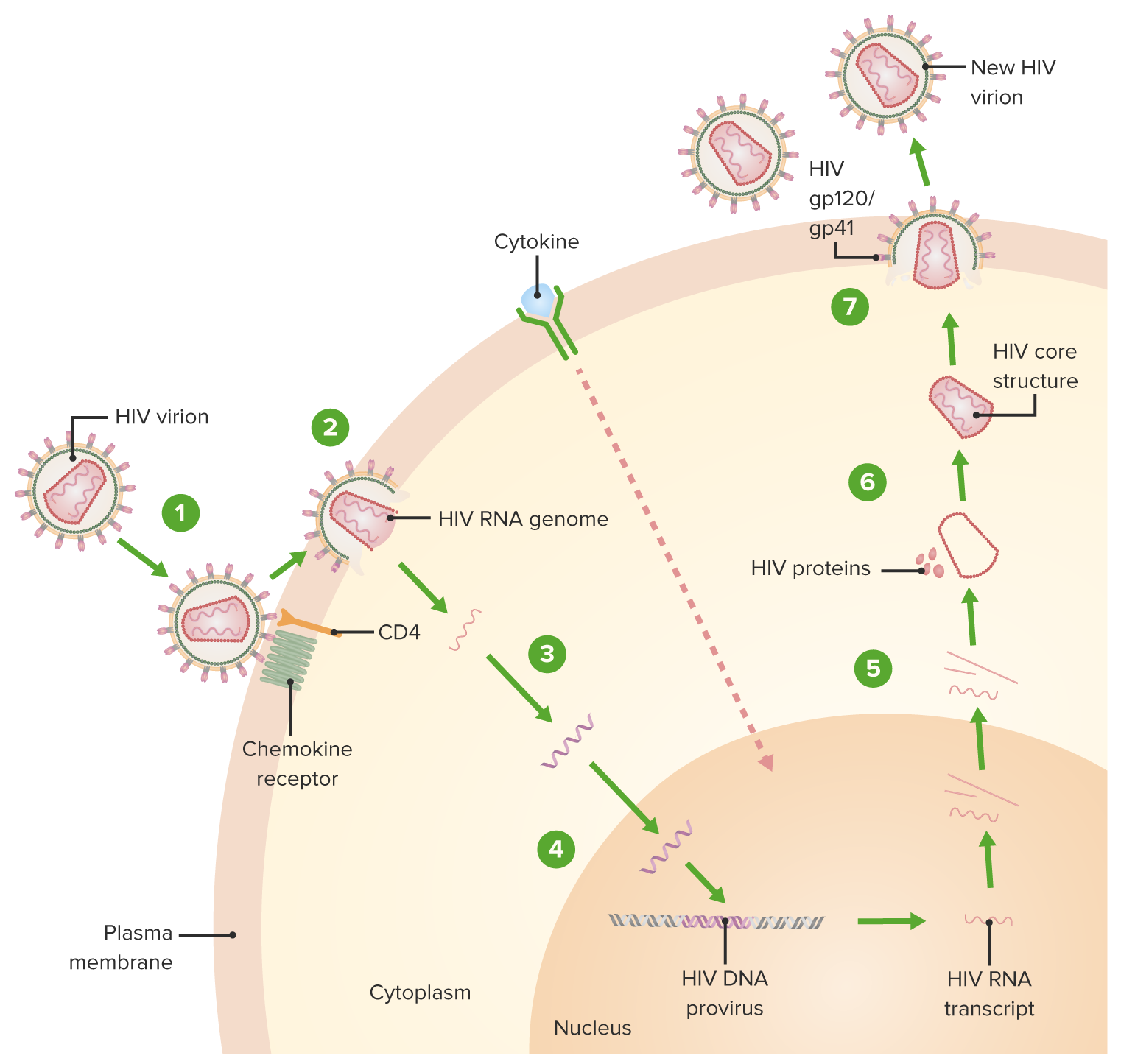Playlist
Show Playlist
Hide Playlist
HIV-associated Meningoencephalitis
-
Slides 10 CNSInfections Neuropathology I.pdf
-
Download Lecture Overview
00:01 Now, we have CNS infection being caused by HIV. 00:05 We call this aseptic meningitis. 00:07 Aseptic. 00:08 It’s a virus. 00:10 One to two weeks of seroconversion in about 10%. 00:14 Now, what about HIV? Now, this is a big topic, isn’t it? So from microbiology, we have plenty, plenty of questions that are always being bombarded to you on HIV. 00:24 And once you’re in that immunocompromised state, there are all kinds of issues that might take place either in a form of microbiology, or with cancers. 00:34 Invasion of the nervous system has been shown to be mild lymphocytic meningitis. 00:40 We could have perivascular type of inflammation and some myelin loss. 00:44 Let’s talk about HIV meningoencephalitis. 00:49 Dementia, ataxia, incontinence, and seizures. 00:53 At first, we have vacuolar myelopathy found in AIDS patient. 00:58 What happened? Microscopically resembles subacute, combined degeneration. 01:03 Remember vitamin B12 deficiency and subacute combined. 01:07 What do you mean by combined? You could have issues with the dorsal column. 01:12 So you have problems with touch, vibration and proprioception. 01:15 You could have your lateral corticospinal tract being affected. 01:19 And of course, your spinal cerebellar resulting in ataxia. 01:24 Keep that in mind with AIDS patient, who behaves like your B12-deficient subacute combined degeneration. 01:31 AIDS-associated peripheral neuropathy. 01:34 Demyelinating polyneuropathy. 01:38 Distal symmetric. 01:39 Polyradiculopathy, and mononeuritis multiplex with AIDS. 01:45 Basically, you have multiple, multiple nerves that are being affected undergoing severe neuropathy. 01:50 Peripheral, peripheral. 01:52 So we have vacuolar myelopathy and we have AIDS-associated peripheral neuropathies. 02:00 You’ve been with me long enough to know that whatever that I give you has to be properly integrated. 02:06 You’ve been with me long enough where I’m always, always reinforcing organization and what the big picture is. 02:13 The reason that I bring this to your attention and you also had been with me long enough where I’m always giving you the clinical picture of your patient so that your able to quickly identify your pathology, correct? No exception here. 02:26 This is AIDS-associated myopathy. 02:31 Don’t get upset with me right now, just bear with me. 02:35 So you’re reading a stem of a question and in the stem of a question, the patient is having proximal weakness, pain, elevated levels of serum creatine kinase. 02:45 Stop there and truly understand that statement. 02:49 What’s my topic for this entire section? It’s CNS infections. 02:54 CNS infection. 02:56 Brain. 02:57 But yet here, I’m talking about muscle? Yes. 03:01 Because you’re reading a stem of a question or the clinical presentation of a patient walking through the door. 03:07 When they have AIDS, there is no part of the body that is spared including the muscle. 03:14 So you’re reading a stem of a question or you’re a chart of your patient, and you realize the patient has AIDS. 03:20 There is muscle weakness. 03:21 You find serum creatine kinase to be elevated. 03:24 The patient has neuropathy, maybe wrist drop, foot drop, so on and so forth. 03:30 Or might have some of the CNS issues that we’ve talked about earlier. 03:34 You put all of these together and make sure that you then choose the correct answer or in clinical practice, choose the proper management of what you’re trying to address. 03:47 Am I clear? So here, we have AIDS-associated myopathy. 03:52 In the spectrum of AIDS, you could have muscle issues. 03:57 Microscopically, what are you going to find? Muscle fiber necrosis, interstitial infiltration of HIV, cytoplasmic bodies. 04:06 We have something called nemaline rods. 04:08 And ragged red fibers, AZT myopathy. 04:14 Is this clear? It has to be. 04:17 Why is this here? Because with AIDS, you truly cannot talk about AIDS, infection of the brain without talking about just as a brief note AIDS infection of – or HIV infection of your muscle.
About the Lecture
The lecture HIV-associated Meningoencephalitis by Carlo Raj, MD is from the course CNS Infections - Clinical Neurology.
Included Quiz Questions
A 48-year-old patient with a history of HIV presents to the ER with fatigue, pain, and muscle weakness. On examination, weakness is noted in his proximal muscles. His CD4 count is 100 cells/uL. His labs show an increase in serum creatine kinase. Which of the following is the least likely finding in his condition?
- Presence of granulomas
- Presence of nemaline rods
- Presence of HIV-positive macrophages
- Presence of muscle fiber necrosis
- Presence of cytoplasmic bodies
Which of the following is NOT a common peripheral neuropathy that is associated with AIDS?
- Proximal symmetric polyneuropathy
- Inflammatory demyelinating polyneuropathy
- Distal symmetric polyneuropathy
- Polyradiculopathy
- Mononeuritis multiplex
A 58-year-old male patient with a history of long-standing HIV presents to the clinic with muscle weakness. His medical history includes hypertension, type 2 diabetes mellitus, and tuberculosis. He is a chronic smoker. His medications are metformin, amlodipine, zidovudine, and rifampicin. Which of the following statements is true?
- Zidovudine (AZT)-associated "ragged red" fibers myopathy
- Zidovudine (AZT)-associated "nemaline rod" myopathy
- Zidovudine (AZT)-associated muscle fiber necrosis
- Zidovudine (AZT)-associated inflammatory myopathy
- Rifampicin-associated inflammatory myopathy
Customer reviews
5,0 of 5 stars
| 5 Stars |
|
1 |
| 4 Stars |
|
0 |
| 3 Stars |
|
0 |
| 2 Stars |
|
0 |
| 1 Star |
|
0 |
Dr. Raj's lectures are always key to understanding the pathophysiology of every disease. Really high-yield!






